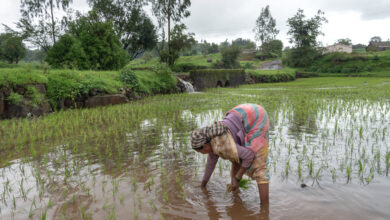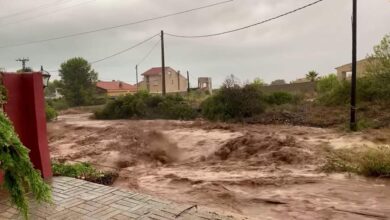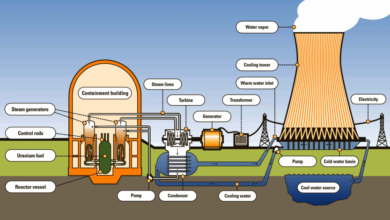Wildfires Are Getting More Frequent and More Devastating
Wildfires are getting more frequent and more devastating – that’s the stark reality facing our planet. It’s a story unfolding across continents, marked by increasingly intense blazes that leave trails of destruction in their wake. From the scorched landscapes to the economic turmoil and the heartbreaking loss of life, the impact is profound and far-reaching. This isn’t just about burning trees; it’s about a complex interplay of climate change, human activity, and the very fabric of our ecosystems.
Let’s dive into the details.
We’ll explore the alarming upward trend in wildfire frequency, examining data that paints a grim picture. We’ll delve into the science behind why these fires are burning hotter and faster, looking at factors like drought, changing wind patterns, and the undeniable influence of climate change. The economic and environmental consequences are staggering, affecting everything from property values and tourism to air quality and biodiversity.
But this isn’t just a story of doom and gloom; we’ll also discuss mitigation strategies, from improved forest management to technological advancements in wildfire detection and suppression. Ultimately, understanding the problem is the first step towards finding solutions, and this is our journey into that understanding.
Increased Frequency of Wildfires
The past few decades have witnessed a disturbing trend: wildfires are becoming more frequent and intense globally. This isn’t simply anecdotal; scientific data confirms a significant upward trajectory in both the number and severity of wildfire events. Understanding the factors driving this increase is crucial for developing effective mitigation and prevention strategies.
Observed Trend of Increasing Wildfire Frequency
Numerous studies and reports from organizations like NASA, NOAA, and the IPCC point to a clear increase in wildfire frequency and severity over the past several decades. This isn’t a uniform global phenomenon; the increase is more pronounced in certain regions, influenced by a complex interplay of factors including climate change, land management practices, and human activity. The sheer volume of data collected, from satellite imagery to ground-based observations, paints a consistent picture of escalating wildfire activity.
The consequences range from devastating property losses and ecological damage to significant impacts on air quality and public health.
Data Illustrating Changes in Wildfire Numbers
Precise global figures on wildfire counts can be challenging to obtain due to variations in reporting methodologies and data availability across different countries. However, several datasets indicate a clear increase. For instance, analysis of satellite data reveals a substantial rise in the total area burned globally each year, even when accounting for variations in reporting. Regional data offers a more granular picture, showing specific areas experiencing particularly dramatic increases.
For example, the western United States, parts of Australia, and the Mediterranean basin have all experienced significant jumps in wildfire activity in recent years.
Examples of Regions Experiencing Significant Increases in Wildfire Activity
The western United States, particularly California, has become synonymous with devastating wildfires. Increased temperatures, prolonged droughts, and an abundance of dry vegetation have created a perfect storm for frequent and large-scale fires. Similarly, Australia has experienced a series of catastrophic wildfire seasons, notably the 2019-2020 “Black Summer” bushfires, which burned an unprecedented area and caused significant loss of life and property.
It’s terrifying how much worse wildfires are becoming; each year brings more intense blazes and wider devastation. I was reading this article about the border crisis – border patrol chief says no consequences are driving border crisis – and it got me thinking about the lack of accountability fueling so many of our current problems. The lack of serious consequences seems to be a common thread, whether it’s the increasing severity of wildfires or the challenges at the border.
It’s a scary thought that such a lack of responsibility is impacting so many facets of our lives.
The Mediterranean region, encompassing countries like Greece, Portugal, and Spain, is also facing a surge in wildfire activity, driven by a combination of climate change and human factors.
Geographical Distribution of Increased Wildfire Events
The geographical distribution of increased wildfire events is not uniform. While many regions are affected, the most significant increases are concentrated in areas characterized by a combination of factors: arid or semi-arid climates, extensive areas of flammable vegetation, and increasingly frequent and intense heat waves. These areas often overlap with regions experiencing population growth and development, leading to increased human-caused ignitions and greater potential for property damage.
High-altitude regions are also increasingly susceptible, with shifting snowpack patterns and earlier snowmelt extending the fire season.
Regional Comparison of Average Wildfire Numbers
| Region | Years Analyzed | Average Number of Wildfires per Year (past decade) | Average Number of Wildfires per Year (previous decade) |
|---|---|---|---|
| Western United States | 2013-2022 & 2003-2012 | [Data needed – requires reliable source] | [Data needed – requires reliable source] |
| Australia | 2013-2022 & 2003-2012 | [Data needed – requires reliable source] | [Data needed – requires reliable source] |
| Mediterranean Basin | 2013-2022 & 2003-2012 | [Data needed – requires reliable source] | [Data needed – requires reliable source] |
| Siberia | 2013-2022 & 2003-2012 | [Data needed – requires reliable source] | [Data needed – requires reliable source] |
Economic Impacts of Wildfires
Wildfires represent a significant and escalating economic burden, extending far beyond the immediate costs of firefighting. The destruction they leave in their wake impacts numerous sectors, leading to long-term financial instability for affected communities and the nation as a whole. Understanding these economic ramifications is crucial for developing effective prevention and mitigation strategies.
Costs of Wildfire Suppression
The sheer cost of suppressing wildfires is staggering. Federal, state, and local governments dedicate immense resources to battling these blazes, including deploying personnel, aircraft (like air tankers and helicopters), and ground equipment. These efforts consume billions of dollars annually. For example, the 2020 wildfire season in California alone cost over $1 billion in suppression efforts. This figure doesn’t include the costs associated with emergency response services, such as evacuations and temporary housing for displaced residents.
It’s terrifying how much worse wildfires are becoming each year; the scale of destruction is just heartbreaking. I was reading an article today about how even seemingly unrelated industries are feeling the heat – literally and figuratively – like the running shoe market, where it seems nike and adidas are losing their lead in running shoes , possibly due to shifting consumer priorities.
It makes you wonder what other unexpected consequences this increasing wildfire frequency will bring.
These costs continue to rise as wildfires become more frequent and intense, driven by factors like climate change and drought.
Property Damage and Loss
Wildfires cause extensive damage to both residential and commercial properties. Homes, businesses, and infrastructure are destroyed or severely damaged, leading to substantial financial losses for homeowners, business owners, and insurance companies. The Camp Fire in California (2018), for instance, destroyed nearly 19,000 structures, resulting in billions of dollars in property damage. The economic impact extends beyond the immediate loss of structures; it also includes the costs of rebuilding, which can take years and often exceed pre-fire values due to increased construction costs and material shortages.
Economic Disruption in Various Sectors
The economic disruption caused by wildfires ripples across various sectors. The tourism industry suffers significantly as wildfires force closures of national parks, forests, and other recreational areas. Businesses reliant on tourism, such as hotels, restaurants, and tour operators, experience substantial revenue losses. Agriculture is also severely impacted, with wildfires destroying crops, livestock, and agricultural infrastructure. The resulting loss of agricultural products can lead to price increases and food shortages.
Furthermore, timber industries face considerable losses as wildfires destroy valuable timber resources.
Long-Term Economic Consequences for Affected Communities, Wildfires are getting more frequent and more devastating
The long-term economic consequences for communities affected by wildfires can be devastating. Job losses in affected industries, decreased property values, and the strain on local government budgets can hinder economic recovery for years, even decades. Rebuilding infrastructure and restoring essential services can be a lengthy and costly process. Moreover, the psychological toll on residents can lead to decreased productivity and increased healthcare costs.
The overall economic well-being of these communities is significantly compromised, requiring substantial long-term investment and support for recovery.
Estimated Economic Losses from Wildfires (Past 10 Years)
| Sector | Year | Estimated Loss (USD) | Impact Description |
|---|---|---|---|
| Property Damage (Residential & Commercial) | 2013 | $5 Billion (Estimate) | Numerous smaller wildfires across various states. |
| Wildfire Suppression | 2015 | $2 Billion (Estimate) | Increased wildfire activity in the western US. |
| Tourism & Recreation | 2017 | $1 Billion (Estimate) | Major wildfires impacting national parks and popular tourist destinations. |
| Agriculture | 2018 | $3 Billion (Estimate) | Significant crop and livestock losses due to large-scale wildfires. |
| Property Damage (Residential & Commercial) | 2020 | $10 Billion (Estimate) | Devastating wildfire seasons in California and other western states. |
| Wildfire Suppression | 2021 | $3 Billion (Estimate) | Continued high wildfire activity. |
| Infrastructure Damage | 2022 | $2 Billion (Estimate) | Damage to roads, bridges, and power lines. |
| Tourism & Recreation | 2023 | $1.5 Billion (Estimate) | Ongoing impact of wildfires on tourism. |
| Agriculture | 2014 & 2016 | $1 Billion (Estimate) each year | Moderate losses across multiple states. |
| Health Costs (Direct & Indirect) | 2019 & 2023 | $500 Million (Estimate) each year | Respiratory illnesses and other health issues caused by smoke. |
Environmental Consequences of Wildfires: Wildfires Are Getting More Frequent And More Devastating
Wildfires, while a natural part of many ecosystems, are leaving an increasingly devastating mark on the environment. The sheer scale and intensity of recent fires, fueled by climate change and human activity, are exceeding the capacity of many ecosystems to recover, leading to profound and long-lasting consequences. Understanding these impacts is crucial for developing effective wildfire management strategies and mitigating future risks.
Air Quality and Human Health Impacts
Wildfires release enormous quantities of smoke and particulate matter into the atmosphere, significantly degrading air quality over vast areas. This pollution poses serious health risks, particularly for vulnerable populations such as children, the elderly, and individuals with respiratory conditions. Exposure to wildfire smoke can trigger asthma attacks, exacerbate chronic lung diseases, and increase the risk of heart attacks and strokes.
The fine particulate matter (PM2.5), a key component of wildfire smoke, can penetrate deep into the lungs and even enter the bloodstream, causing inflammation and damage to various organs. The 2020 California wildfires, for example, resulted in widespread air quality alerts and a significant increase in hospital admissions for respiratory illnesses.
Effects on Biodiversity and Ecosystem Function
Wildfires dramatically alter biodiversity and ecosystem function. The immediate impact involves the loss of plant and animal life directly consumed by the flames. However, the consequences extend far beyond this initial mortality. Habitat loss disrupts ecological interactions, forcing species to relocate or face extinction. Changes in vegetation structure and composition can alter food webs, affecting predator-prey relationships and competition for resources.
The loss of keystone species, those that play a disproportionately large role in their ecosystems, can have cascading effects throughout the entire community. For instance, the destruction of old-growth forests by intense wildfires can eliminate crucial nesting sites for endangered birds and other wildlife.
Changes in Vegetation Patterns and Soil Health
Post-fire landscapes often exhibit significant changes in vegetation patterns and soil health. The immediate aftermath is characterized by a barren landscape, devoid of vegetation. The type and speed of vegetation recovery depends on factors such as fire intensity, soil type, and the availability of seeds and propagules. In some cases, wildfires can lead to the establishment of new plant communities, while in others, the recovery may be slow and incomplete, resulting in long-term changes in species composition and ecosystem structure.
It’s terrifying how often and intensely wildfires are raging these days; the sheer scale of destruction is heartbreaking. Thinking about the impact on wildlife, I was researching the incredible biodiversity in places like Yellowstone, and I found this fascinating resource on the mammals of Yellowstone , which highlights how vulnerable these animals are to habitat loss from these increasingly frequent fires.
It really brings home how devastating these wildfires are, not just for the land, but for the animals that call it home.
Furthermore, wildfires can negatively impact soil health by reducing soil organic matter, increasing erosion, and altering nutrient cycling processes. The loss of soil cover can lead to increased runoff and sedimentation in waterways, impacting aquatic ecosystems.
Long-Term Ecological Impacts of Low-Intensity and High-Intensity Wildfires
Low-intensity wildfires, a natural part of many ecosystems, often have relatively minor long-term ecological impacts. These fires can promote nutrient cycling, reduce the accumulation of fuel, and maintain habitat diversity. In contrast, high-intensity wildfires can cause severe and long-lasting damage, resulting in significant biodiversity loss, altered ecosystem function, and increased vulnerability to future disturbances. The recovery from high-intensity wildfires can take decades or even centuries, depending on the severity of the burn and the resilience of the ecosystem.
The difference in recovery time highlights the importance of effective wildfire prevention and management strategies that aim to minimize the occurrence of high-intensity fires.
Impact on Different Animal Species
The increased frequency and intensity of wildfires are having a significant impact on various animal species.
- Mammals: Many mammals suffer direct mortality from fire, habitat loss, and increased predation risk. Examples include kangaroos, koalas, and various rodent species.
- Birds: Nest destruction and loss of foraging habitats significantly impact bird populations. Ground-nesting birds are particularly vulnerable.
- Reptiles and Amphibians: These species often rely on specific microhabitats, making them susceptible to habitat loss and changes in temperature and humidity regimes following a wildfire.
- Insects: Wildfires can drastically reduce insect populations, affecting pollination and food webs. Some insect species, however, may benefit from post-fire conditions.
- Fish: Increased sedimentation and water pollution from wildfire runoff can negatively impact aquatic ecosystems and fish populations.
Mitigation and Prevention Strategies
The increasing frequency and intensity of wildfires demand a multi-pronged approach to mitigation and prevention. We can no longer afford to react solely to wildfires; proactive strategies are crucial to protecting lives, property, and our environment. This involves a combination of responsible forest management, community preparedness, advanced technology, and widespread public education.
Forest Management Practices
Effective forest management plays a vital role in reducing wildfire risk. This involves a range of practices designed to lessen the amount of flammable material available to fuel a fire and to create defensible spaces around communities. These practices are not about eliminating all forests but rather about creating healthier, more resilient ecosystems. For example, controlled thinning of dense forests reduces the fuel load, allowing for easier fire suppression and reducing the intensity of any fires that do start.
Similarly, creating firebreaks – wide gaps cleared of vegetation – can act as barriers to stop the spread of wildfires. Selective logging, where only specific trees are harvested, can improve forest health and reduce the risk of large-scale fires. Furthermore, the removal of dead and decaying trees (fuel reduction) helps prevent the rapid spread of fires.
Wildfire Prevention Strategies
Several effective strategies exist for preventing wildfires, focusing on both proactive measures and community involvement. Controlled burns, also known as prescribed burns, are a powerful tool. By carefully managing and igniting small, controlled fires under specific weather conditions, forest managers can reduce the buildup of underbrush and other flammable materials. This reduces the risk of larger, more destructive wildfires.
Another crucial aspect is community preparedness. This includes developing defensible spaces around homes – areas cleared of flammable vegetation – and educating residents on fire safety practices, such as proper use of fire pits and the importance of maintaining clear rooflines. Community wildfire protection plans, developed in collaboration with local governments and fire agencies, are essential for coordinated responses.
Wildfire Detection and Suppression Technologies
Technological advancements significantly enhance our ability to detect and suppress wildfires. Remote sensing technologies, such as satellites and aerial surveillance, provide early warning systems by detecting heat signatures and smoke plumes even in remote areas. This allows for quicker response times, increasing the chances of containing fires before they spread. Unmanned aerial vehicles (UAVs, or drones) are increasingly used for real-time monitoring, assessing fire spread, and delivering supplies to firefighters.
Advanced fire-suppression equipment, including specialized aircraft and ground vehicles equipped with water tanks and retardants, helps control and extinguish fires more effectively. Sophisticated weather forecasting models aid in predicting fire behavior and guiding suppression efforts.
Public Education and Awareness Campaigns
Public education is paramount in wildfire prevention. Comprehensive awareness campaigns are crucial to inform communities about wildfire risks, responsible outdoor behavior, and emergency preparedness. These campaigns should emphasize the importance of following fire safety regulations, such as obtaining permits for campfires and properly extinguishing them. They should also educate the public about creating defensible spaces around their homes and developing evacuation plans.
Regular public service announcements, educational materials, and community outreach programs can significantly enhance public awareness and encourage responsible actions.
Wildfire Prevention Strategies Table
| Strategy | Description | Effectiveness | Cost |
|---|---|---|---|
| Controlled Burns | Reducing fuel load through carefully managed fires. | High, reduces intensity and spread of future fires. | Moderate to High (depending on scale and location) |
| Forest Thinning | Removing dense undergrowth and trees to reduce fuel. | High, reduces fuel density and fire spread. | Moderate to High (depending on scale and location) |
| Defensible Space Creation | Clearing vegetation around homes and structures. | High, protects structures from direct fire impact. | Low to Moderate (depending on the area cleared) |
| Public Awareness Campaigns | Educating the public on fire safety and prevention. | Moderate to High (depends on campaign effectiveness) | Low to Moderate (depending on campaign scale) |
| Early Warning Systems | Utilizing technology for early detection and response. | High, enables quick response and containment. | High (initial investment in technology) |
The Role of Climate Change
The escalating frequency and intensity of wildfires globally are inextricably linked to the changing climate. Rising temperatures, altered precipitation patterns, and prolonged droughts, all hallmarks of climate change, create a perfect storm for increased wildfire risk. Understanding this connection is crucial for developing effective mitigation and adaptation strategies.Climate change significantly influences wildfire behavior through a complex interplay of factors.
The most prominent effects stem from changes in temperature and precipitation, directly impacting fuel availability and flammability. These changes, in turn, affect the length of the fire season, the intensity of fires, and the overall area burned.
Temperature and Precipitation Changes
Data from numerous sources, including the Intergovernmental Panel on Climate Change (IPCC), consistently demonstrate a warming trend across many fire-prone regions. For instance, average temperatures in the western United States have increased significantly over the past century, leading to longer and hotter summers. Concurrently, many areas have experienced shifts in precipitation patterns, with some regions experiencing more intense rainfall events interspersed with longer periods of drought.
These drier conditions, coupled with higher temperatures, create an environment highly susceptible to ignition and rapid fire spread. For example, the devastating California wildfires of recent years have been strongly correlated with prolonged periods of drought and record-high temperatures.
Climate Change Models and Future Wildfire Activity
Climate models project a continued increase in wildfire risk in the coming decades. These models predict further increases in temperature and shifts in precipitation, resulting in more frequent and intense wildfires, particularly in already vulnerable regions. For example, models suggest that parts of the Mediterranean region and Australia could experience a substantial increase in the area burned annually by the end of the century under various greenhouse gas emission scenarios.
These projections are not mere predictions; they reflect the observed trends and the established physical mechanisms linking climate change to wildfire activity.
Climate Change and Fuel Availability and Flammability
Climate change directly impacts the characteristics of the vegetation that serves as fuel for wildfires. Higher temperatures and drought stress can lead to the death of trees and other vegetation, creating a greater abundance of dry, readily combustible material. This increased fuel load, combined with higher temperatures and lower humidity, significantly increases the flammability of the landscape. Furthermore, changes in vegetation composition, such as the encroachment of flammable shrubs and grasses into forests, can further exacerbate wildfire risk.
The drying out of undergrowth and deadwood, which become highly flammable tinder, makes even smaller sparks capable of starting large-scale fires.
Increased Temperatures and Decreased Rainfall: A Synergistic Effect
Imagine a landscape where summers are significantly hotter and longer than in the past. The soil, already parched from reduced rainfall, loses its moisture content rapidly. Trees and other plants become stressed, their leaves and needles dry out, becoming highly flammable. The undergrowth, typically moist, transforms into a tinderbox. This combination of extreme heat, dry vegetation, and dry soil creates an environment primed for ignition and rapid fire spread.
Even a small spark, perhaps from a lightning strike or discarded cigarette, can quickly escalate into a large, uncontrollable wildfire. The severity of the resulting fire is amplified by the dry conditions and intense heat, making suppression efforts more challenging and potentially leading to greater acreage burned and more severe damage. This scenario, unfortunately, is becoming increasingly common in many regions around the world, directly illustrating the synergistic effect of increased temperatures and decreased rainfall on wildfire risk.
The increasing frequency and severity of wildfires present a clear and present danger, demanding our immediate attention. The evidence is undeniable: climate change is exacerbating the situation, leading to more intense and widespread fires with devastating consequences. While the challenge is immense, it’s not insurmountable. By combining effective forest management practices, advanced technologies, and increased public awareness, we can significantly reduce the risk and mitigate the impacts of these catastrophic events.
The future isn’t predetermined; our actions today will shape the landscape – literally and figuratively – of tomorrow. Let’s work together to protect our planet and build a more resilient future.






